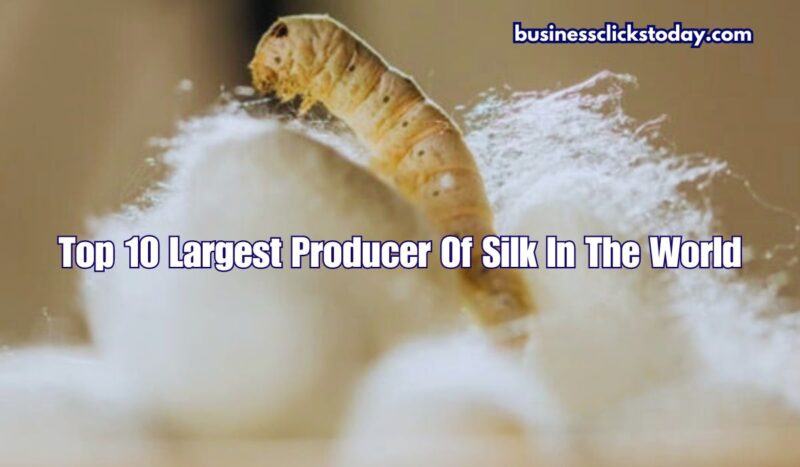Thousands of years ago, an incredible discovery was made: transforming caterpillar threads into luxurious fabric. Fast forward to 2024, and silk production has become a massive global industry, with hundreds of thousands of metric tons produced annually. This transformation from ancient craft to modern industry is fascinating, and understanding how we arrived here provides a glimpse into the world’s largest silk producers. In this article, we’ll explore the top ten silk-producing countries as of 2024, revealing who stands as the largest producer of silk in the world and how each nation contributes to this enduring tradition.
Top 10 Largest Producer Of Silk In The World 2024
1. China
When discussing the largest producer of silk in the world, China stands out unequivocally. With a staggering 46,700 metric tons of silk produced annually, China leads the global market by a significant margin. The country’s silk industry is not just vast in scale but deeply rooted in history. Silk production in China dates back thousands of years, weaving a rich tapestry of tradition and innovation. The process, known as sericulture, involves carefully cultivating silkworms and harvesting their threads. This ancient practice has been passed down through generations, resulting in some of the highest quality silk available today. China’s silk is not just a product but a symbol of historical craftsmanship blended with contemporary techniques.
2. India
Trailing closely behind China, India produces an impressive 34,904 metric tons of silk each year. India’s silk industry is characterized by its diversity, encompassing various types such as Mulberry, Eri, Tasar, and Muga. Each type of silk boasts unique characteristics, reflecting the country’s rich cultural heritage. Sericulture in India is more than an economic activity; it is a vital source of livelihood for many in rural areas. The intricate patterns and vibrant colors of Indian silk fabrics highlight the country’s commitment to preserving traditional techniques while adapting to modern demands.
3. Uzbekistan
Uzbekistan, though producing a smaller 2,037 metric tons of silk compared to China and India, plays a significant role in the global silk market. The country’s silk industry is steeped in history, reminiscent of the legendary Silk Road that once connected East and West. Uzbek silk is renowned for its bold patterns and unique Ikat fabrics. This tradition of silk production not only preserves historical techniques but also celebrates local artistic expression, making Uzbekistan a notable player in the silk industry.
4. Vietnam
With an annual production of 1,067 metric tons, Vietnam is becoming a prominent name in the silk industry. The country’s silk is distinguished by its quality and craftsmanship, often showcased in the famous Van Phuc Silk Village. Here, traditional weaving techniques have been preserved, producing silk with exceptional texture and durability. Vietnamese silk is gaining international acclaim for its fine quality, making Vietnam a rising star in the global silk market.
5. Thailand
Thailand contributes 503 metric tons of silk annually, with the northeastern region of Isaan being the heart of silk production. Thai silk is celebrated for its luxurious texture and vibrant colors, achieved through unique dyeing techniques. Silk production in Thailand is not just about the product; it is deeply embedded in the local lifestyle and culture. The world’s fascination with Thai silk reflects its blend of traditional craftsmanship and contemporary style.
6. Brazil
Surprisingly, Brazil is making waves in the silk industry with an annual production of 373 metric tons. Although relatively new to silk production compared to other countries, Brazil has rapidly advanced by adopting modern technologies and improving farming practices. Brazilian silk is noted for its fine quality, and the country is establishing itself as a key player in the global market, demonstrating how innovation can propel a new entrant into a significant position.
7. North Korea
North Korea produces 370 metric tons of silk each year, often under strict state control. Despite its isolation from the global market and economic sanctions, North Korea maintains a steady silk industry. The Kim Jong Suk Silk Mill in Pyongyang is a major contributor to this production. North Korea’s silk industry is marked by a unique blend of self-reliance and resilience, producing high-quality silk despite its limited international engagement.
8. Iran
Iran, with its 272 metric tons of silk production, has a long-standing tradition in the silk industry, dating back over 3,000 years. The Silk Road, which once passed through Iran, played a significant role in its silk history. Iranian silk is renowned for its high quality, often used in luxurious Persian rugs and textiles. The country’s silk industry combines ancient techniques with modern advancements, preserving its cultural heritage while adapting to contemporary markets.
9. Bangladesh
Bangladesh, producing 41 metric tons of silk annually, is a newer player in the silk industry. Most of the silk production here is concentrated in rural areas, characterized by small-scale operations and traditional weaving methods. Bangladeshi silk is notable for its sustainability and community focus, reflecting the country’s commitment to preserving traditional practices while integrating modern approaches.
10. Japan
Japan, although producing only 10 metric tons of silk each year, is renowned for its exceptional quality. Japanese silk is closely tied to cultural practices, such as the production of kimonos. Despite its smaller scale, the precision and skill involved in Japanese silk production ensure that the silk is of extraordinary quality. Japan’s approach emphasizes craftsmanship and cultural significance, making its silk highly valued.
Conclusion
In summary, the world of silk production is a testament to the blend of ancient traditions and modern advancements. China, as the largest producer of silk in the world, sets the benchmark for both quantity and quality, while other countries like India, Uzbekistan, and Vietnam contribute significantly with their unique contributions. Each of these silk-producing nations adds its own flavor to the global market, whether through historical legacy or innovative techniques. As demand for silk continues to grow, these countries play crucial roles in sustaining and evolving this timeless craft. Understanding where all that silk comes from not only enriches our appreciation of this luxurious fabric but also highlights the ongoing global dedication to its production.
















